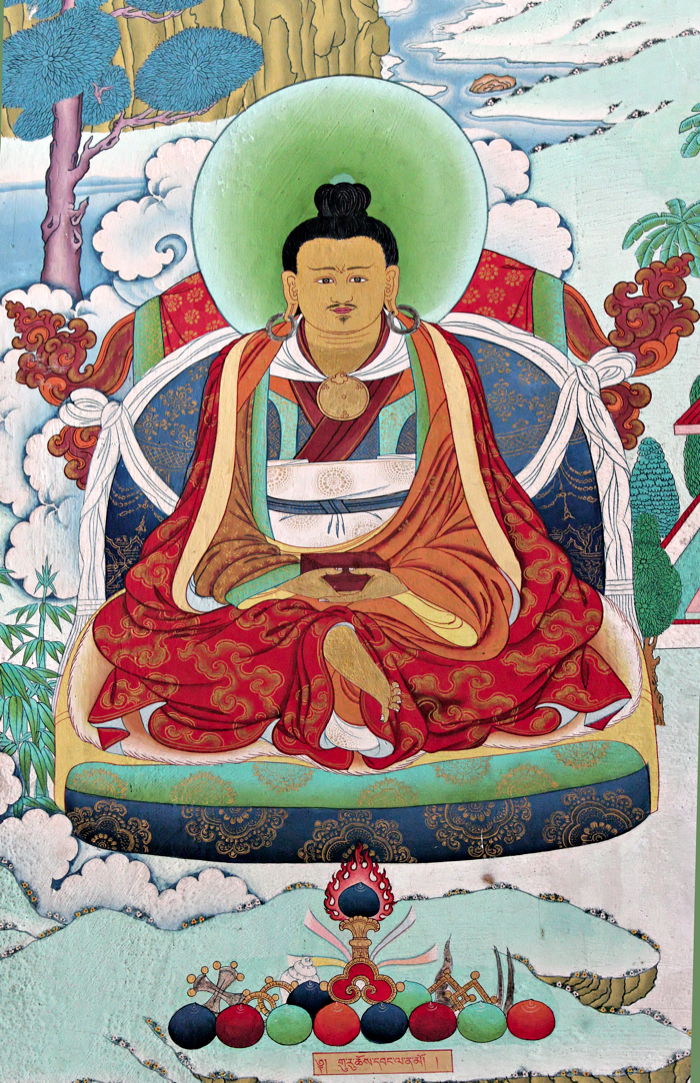|
Dark Retreat
Dark retreat (Allione, Tsultrim (2000). ''Women of Wisdom''. (Includes transcribed interview with Namkhai Norbu) Source(accessed: November 15, 2007)) is a spiritual retreat in a space that is completely absent of light, which is an advanced practice of Tibetan Buddhism and Bön. Overview The dark retreat environment of the Bon religion is particularly conducive to the practice of certain visionary yogas (such as the “six-limbed yoga” of Kalacakra and the Dzogchen practice of ''Thögal'' for the attainment of the Rainbow Body), which according to Hatchell are "techniques that lead to the experience of spontaneously arising visual experiences, which are said to occur without deliberate effort or conceptual imagination, and which appear before the practitioner’s eyes." According Hatchell, the Kalacakra system's six yogas:instruct the yogi to spend lengthy periods either gazing at the blank sky or residing in a dark room specially prepared to seal out all light. Both of thes ... [...More Info...] [...Related Items...] OR: [Wikipedia] [Google] [Baidu] |
Namkhai Norbu
Namkhai Norbu (; 8 December 1938 – 27 September 2018) was a Tibetan Buddhist master of Dzogchen and a professor of Tibetan and Mongolian language and literature at Naples Eastern University. He was a leading authority on Tibetan culture, particularly in the fields of history, literature, traditional religions (Tibetan Buddhism and Bon), and Traditional Tibetan medicine, having written numerous books and scholarly articles on these subjects. When he was two years old, Norbu was recognized as the mindstream emanation, a tulku, of the Dzogchen teacher Adzom Drugpa (1842–1924). At five, he was also recognized as a mindstream emanation of an emanation of Shabdrung Ngawang Namgyel (1594–1651). At the age of sixteen, he met master Rigdzin Changchub Dorje (1863–1963), who became his main Dzogchen teacher. In 1960, he went to Italy at the invitation of Giuseppe Tucci and served as Professor of Tibetan and Mongolian Language and Literature from 1964 to 1992 at Naples Eastern U ... [...More Info...] [...Related Items...] OR: [Wikipedia] [Google] [Baidu] |
Ayu Khandro
Ayu Khandro (, "Long Life Dakini", 1839 – 1953), also known as Dorje Paldrön, was a Tibetan yogini, practitioner and terton of Tantric Buddhism in Eastern Tibet. An accomplished Dzogchen meditator, she is known for her extensive pilgrimages throughout Tibet, long periods of dark retreat practice, the gongter of the practice of the yidam Senge Dongma (the Lion-Faced Dakini), various forms of Chöd, and her lifelong dedication to spiritual practice. Much of the information we have about Ayu Khandro comes from the oral commentary that she gave in person to Chogyal Namkhai Norbu in Dzongsa in 1951. He wrote her namthar, or spiritual biography, which was later published in ''Women of Wisdom'' by Tsultrim Allione. Ayu Khandro met, and was taught by, many great masters of her day: Jamyang Khyentse Wangpo, Jamgon Kongtrul the First, Chokgyur Lingpa, Nyala Pema Dündul, Adzom Drukpa, Togden Rangrig and the ninth Tai Situpa, Pema Nyingche Wangpo. She led the life of a hid ... [...More Info...] [...Related Items...] OR: [Wikipedia] [Google] [Baidu] |
Tibetan Buddhist Practices
Tibetan may mean: * of, from, or related to Tibet * Tibetan people, an ethnic group * Tibetan language: ** Classical Tibetan, the classical language used also as a contemporary written standard ** Standard Tibetan, the most widely used spoken dialect ** Tibetan pinyin, a method of writing Standard Tibetan in Latin script ** Tibetan script ** any other of the Tibetic languages Tibetan may additionally refer to: Culture * Old Tibetan, an era of Tibetan history * Tibetan art * Music of Tibet * Tibetan rug * Tibetan culture * Tibetan cuisine Religion * Tibetan Buddhism * Tibetan Muslims Other uses * Tibetan alphabet * Tibetan (Unicode block) * Tibetan name * Tibetan calendar * Tibetan Spaniel, a breed of dog * Tibetan Mastiff, a breed of dog See also * Tibet (other) * Tibetan Bells (other) * Traditional Tibetan medicine * Tibetan language (other) Tibetan language may refer to: * Lhasa Tibetan or Standard Tibetan, the most widely used spoken dialect * ... [...More Info...] [...Related Items...] OR: [Wikipedia] [Google] [Baidu] |
Spiritual Retreats
Spiritual is the adjective for the noun "spirit" ( animating force or supernatural entity). Spiritual may also refer to: Religion *Spirituality, the quality or state of being spiritual, traditionally referring to a religious process of re-formation that "aims to recover the original shape of man" ** Spiritual activism, a practice that brings together the otherworldly and inward-focused work of spirituality and the worldly and outwardly-focused work of activism ** Spiritual attack, an attack by Satan and his demons on a Christian ** Spiritual body, a Christian concept ** Spiritual but not religious, a religious classification **Spiritual bypass, a tendency to use spiritual ideas and practices to sidestep or avoid facing unresolved emotional issues, psychological wounds, and unfinished developmental tasks ** Spiritual communion, a Christian practice of desiring union with Jesus Christ in the Eucharist ** Spiritual crisis, a form of identity crisis where an individual experiences dr ... [...More Info...] [...Related Items...] OR: [Wikipedia] [Google] [Baidu] |
Meditation
Meditation is a practice in which an individual uses a technique to train attention and awareness and detach from reflexive, "discursive thinking", achieving a mentally clear and emotionally calm and stable state, while not judging the meditation process itself. Techniques are broadly classified into focused (or concentrative) and open monitoring methods. Focused methods involve attention to specific objects like breath or mantras, while open monitoring includes mindfulness and awareness of mental events. Meditation is practiced in numerous religious traditions, though it is also practised independently from any religious or spiritual influences for its health benefits. The earliest records of meditation ('' dhyana'') are found in the Upanishads, and meditation plays a salient role in the contemplative repertoire of Jainism, Buddhism and Hinduism. Meditation-like techniques are also known in Judaism, Christianity and Islam, in the context of remembrance of and prayer and dev ... [...More Info...] [...Related Items...] OR: [Wikipedia] [Google] [Baidu] |
Consciousness
Consciousness, at its simplest, is awareness of a state or object, either internal to oneself or in one's external environment. However, its nature has led to millennia of analyses, explanations, and debate among philosophers, scientists, and theologians. Opinions differ about what exactly needs to be studied or even considered consciousness. In some explanations, it is synonymous with the mind, and at other times, an aspect of it. In the past, it was one's "inner life", the world of introspection, of private thought, imagination, and volition (psychology), volition. Today, it often includes any kind of cognition, experience, feeling, or perception. It may be awareness, awareness of awareness, metacognition, or self-awareness, either continuously changing or not. The disparate range of research, notions, and speculations raises a curiosity about whether the right questions are being asked. Examples of the range of descriptions, definitions or explanations are: ordered distinc ... [...More Info...] [...Related Items...] OR: [Wikipedia] [Google] [Baidu] |
Religion Articles Needing Expert Attention
Religion is a range of social system, social-cultural systems, including designated religious behaviour, behaviors and practices, morals, beliefs, worldviews, religious text, texts, sanctified places, prophecies, ethics in religion, ethics, or religious organization, organizations, that generally relate humanity to supernatural, transcendence (religion), transcendental, and spirituality, spiritual elements—although there is no scholarly consensus over what precisely constitutes a religion. It is an essentially contested concept. Different religions may or may not contain various elements ranging from the divine, sacredness, faith,Tillich, P. (1957) ''Dynamics of faith''. Harper Perennial; (p. 1). and a supernatural being or beings. The origin of religious belief is an open question, with possible explanations including awareness of individual death, a sense of community, and dreams. Religions have sacred histories, narratives, and mythologies, preserved in oral traditions, sac ... [...More Info...] [...Related Items...] OR: [Wikipedia] [Google] [Baidu] |
Menngagde
In Tibetan Buddhism and Bon, Menngagde (, ), is the name of one of three scriptural and lineage divisions within Dzogchen (''Great Perfection'' ). Dzogchen is itself the pinnacle of the ninefold division of practice according to the Nyingma school of Tibetan Buddhism. Menngagde focuses on rigpa. The Menngagde or 'Instruction Class' of Dzogchen teachings are divided into two parts: ''trekchö'' and ''tögel''. Practice For general purposes, Menngagde may also be known as Nyingthik. Germano & Gyatso (2000: p. 240) note a similarity of practice between Chan-like formless meditations and Nyingthik/Menngagde: In the Dzogchen textual tradition Traditionally, Mañjuśrīmitra () is said to have classified all the Dzogchen teachings transmitted by his teacher, Garab Dorje, into three series: semdé (), Longdé (), and menngagdé. Mañjuśrīmitra's student Sri Singha reedited the oral instruction cycle and in this form the teaching was transmitted to Jñānasūtra and Vimal ... [...More Info...] [...Related Items...] OR: [Wikipedia] [Google] [Baidu] |
Dilgo Khyentse
Dilgo Khyentse Rinpoche, Tashi Paljor () (c. 1910 – 28 September 1991) was a Vajrayana master, Terton, scholar, poet, teacher, and recognized by Buddhists as one of the greatest realized masters. Head of the Nyingma school of Tibetan Buddhism from 1988 to 1991, he is also considered an eminent proponent of the Rime tradition. As the primary custodian of the vast collection of teachings both authored by and recovered by Jamyang Khyentse Wangpo, Dilgo Khyentse was the ''de facto'' custodian of a vast majority of Tibetan Buddhist teachings. He taught many eminent teachers, including the 14th Dalai Lama. After the Chinese invasion of Tibet, his personal effort was crucial in the preservation of Tibetan Buddhism. Biography Early life, ancestry Dilgo Khyentse was born on the 3rd day of the 3rd lunar month of the Iron Dog Year (1910), in the Denma region of Derge, in Denkok Valley, in Kham, Eastern Tibet, during a teaching on the Kalachakra Tantra given in his house by Ju Mipham ... [...More Info...] [...Related Items...] OR: [Wikipedia] [Google] [Baidu] |
Rigpa
In Dzogchen, ''rigpa'' (; Skt. Vidya (Knowledge), vidyā; "knowledge") is knowledge of the Ground (Dzogchen), ground. The opposite of ''rigpa'' is ''ma rigpa'' (''Avidyā (Buddhism), avidyā'', ignorance). A practitioner who has attained the state of ''rigpa'' and is able to rest in it continuously is called a ''Rigdzin'' or ''Rigma'' (see Vidyadhara (Buddhism), Vidyadhara), which may be used as a title either pre- or post-nominally. ''Rigpa'' (knowledge) ''Rigpa'' (Sanskrit: ''vidyā'', 'knowledge') is a central concept in Dzogchen. According to Ācārya Malcolm Smith: ''Rigpa'' is the knowledge of the Ground (Dzogchen), ground. It has also come to mean the 'pristine awareness' that is the Ground (Dzogchen), fundamental ground itself. Erik Pema Kunsang translates a text which provides basic definitions of ''rigpa'' and ''ma rigpa'' in a Dzogchen context: Rigpa has two aspects, namely ''kadag'' and ''lhun grub''. ''Kadag'' means "purity" or specifically "primordial purity". ... [...More Info...] [...Related Items...] OR: [Wikipedia] [Google] [Baidu] |
Light
Light, visible light, or visible radiation is electromagnetic radiation that can be visual perception, perceived by the human eye. Visible light spans the visible spectrum and is usually defined as having wavelengths in the range of 400–700 nanometres (nm), corresponding to frequency, frequencies of 750–420 terahertz (unit), terahertz. The visible band sits adjacent to the infrared (with longer wavelengths and lower frequencies) and the ultraviolet (with shorter wavelengths and higher frequencies), called collectively ''optical radiation''. In physics, the term "light" may refer more broadly to electromagnetic radiation of any wavelength, whether visible or not. In this sense, gamma rays, X-rays, microwaves and radio waves are also light. The primary properties of light are intensity (physics), intensity, propagation direction, frequency or wavelength spectrum, and polarization (waves), polarization. Its speed of light, speed in vacuum, , is one of the fundamental physi ... [...More Info...] [...Related Items...] OR: [Wikipedia] [Google] [Baidu] |




